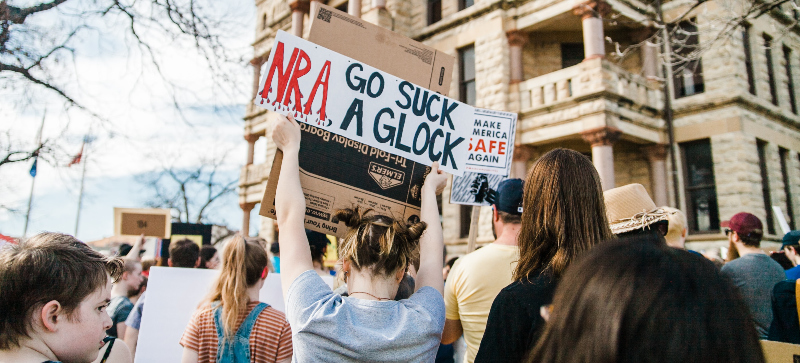
I’ve often thought of the gun-rights issue as something linked to the hunting culture of a place like Wallowa County. At least one of my grandfathers was a hunter. Like many men (and some women) here he hunted deer and elk in the fall, right near the hunting cabin from which I write this post. The meat was part of the family diet, along with fruit and vegetables canned by my grandmother for winter use.
In our cabin, the head of a pronghorn antelope is mounted on one wall. On the opposite wall hangs the tanned skin of a brown bear.
But if the Harvard historian Jill Lepore is correct, the modern gun-rights movement, championed by the National Rifle Association, has a lot more to do with race and racism than it does with hunting.
Lepore notes that the second amendment — “A well regulated militia being necessary to the security of a free State, the rights of the people to keep and bear arms shall not be infringed” — received almost no attention for two centuries. That changed in the 1960s when people like Malcolm X and others in Black Power movements pointed out that blacks too had a constitutional right to own guns and encouraged blacks to arm themselves. You may recall the photos of gun toting Black Panthers of that era.
In the South, the issue predates the 60s Black Power movement. After the Civil War, black veterans who had fought for the Union came home with guns. That was part of what triggered terrorist groups like the KKK. They took it upon themselves to see that African-Americans were disarmed. In the South, guns were for white people.
In her massive one-volume history of the U.S., These Truths, Lepore provocatively terms the gun-rights movement that got under way in the late 60s and 70s, “A rights fight for white men.” So it’s no wonder that gun rights, racism, white nationalism, and issues of masculinity continue to swirl together in a toxic brew.
A second driving force of the gun-rights movement, according to Lepore, was the rise of the anti-immigrant movement, a reaction to the liberalization of U.S. immigration laws in 1965. Previous immigration laws had favored people who were white. Here’s Lepore:
“Part of the backlash against both feminism and civil rights, gun rights became a conservative political movement, a rights fight for white men.”
“If, in the 1960s, the gun debate took place in the shadow of the Black Power movement, in the 1970s it took place in the shadow of a growing White Power movement. A whitelash that began as a reaction against the civil rights movement in the 1960s gained strength i the 1970s and 1980s as a reaction to changing patterns of immigration.”
“The gun rights movement was tightly bound to anti-immigrant animus. The NRA turned itself from a sporting and hunting association into a powerful political interest group during the very years that hostility against immigration was on the rise.”
Again, if Lepore is right, guns, white power, racism, sexism, and anti-immigration sentiments have been bound up together since the get-go of the gun-rights movement. So the El Paso mass shooting two weeks ago, where the shooter set out to “kill Mexicans,” has a long and tortured pre-history. It has been a not-so-stealth movement of white men, wrapped up in specious claims about the Constitution.
Still, we ought to be cautious about oversimplification of a complex issue. Attributing all gun violence to racism provides a reductive, simplistic explanation of a complex,multi-cause reality. It is one significant factor, but the overall problem is more complex. Conservatives, including Trump, also look for one explanation for mass murders with guns. Their favorite is “mental illness.” I suspect that Lepore is right in arguing that racism has a lot more to do with gun violence than “mental illness.”
Outside the NRA’s headquarters stand these words: “The rights of the people to keep and bear arms shall not be infringed.” Note that this part of the second amendment has been shorn of the previous clause and context about a well-regulated militia, that is something like the National Guard.
Understanding this history and the gun-rights movement as being, at least in significant part, a “rights fight for white men,” would go a long way toward explaining why so little progress has been made on gun safety or getting serious about reducing these outrageous mass shootings. It is about a whole lot more than hunting elk.
Photo by Heather Mount on Unsplash

I think this article does what is popular. Wrap a complex problem in racism and in this case throw in sexism. This tactic promotes division with the simple meme gun owners/racist/bad, against the good people who refuse discussion with the ignorant. The people on both ends of the spectrum shout each other down and…well,you already know.